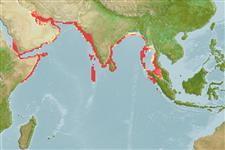>
Eupercaria/misc (Various families in series Eupercaria) >
Nemipteridae (Threadfin breams, Whiptail breams)
Etymology: Parascolopsis: Greek, para in the side of + Greek, skolos = stake + Greek, ops = appearance (Ref. 45335).
Environment: milieu / climate zone / depth range / distribution range
Ökologie
seewasser demersal; standorttreu; tiefenbereich 20 - 300 m (Ref. 58018). Tropical; 31°N - 1°N, 41°E - 101°E (Ref. 3810)
Indian Ocean: including the Persian Gulf; Gulf of Oman, Gulf of Aden, Arabian Sea, Bay of Bengal and the Andaman Sea.
Size / Gewicht / Alter
Maturity: Lm ? range ? - ? cm
Max length : 21.0 cm TL Männchen/unbestimmt; (Ref. 11441); common length : 10.0 cm SL Männchen/unbestimmt; (Ref. 3810)
Rückenflossenstacheln (insgesamt) : 10; Rückenflossenweichstrahlen (insgesamt) : 9; Afterflossenstacheln: 3; Afterflossenweichstrahlen: 7. Head scales reaching forward to between level of anterior margin of eyes and posterior nostrils. Lower limb of preopercle naked. Posterior margin of suborbital smooth or with just a few tiny spines. Pectoral and pelvic fins long, reaching to or beyond level of anus. Axillary scale present. Color: Body rosy-orange; anal fin rosy; pectoral fin yellowish with 2 rudimentary rays.
Benthic on sand or mud bottoms in offshore waters (Ref. 30573). Feeds mainly on benthic invertebrates.
Life cycle and mating behavior
Geschlechtsreife | Fortpflanzung | Ablaichen | Eier | Fecundity | Larven
Russell, B.C., 1990. FAO Species Catalogue. Vol. 12. Nemipterid fishes of the world. (Threadfin breams, whiptail breams, monocle breams, dwarf monocle breams, and coral breams). Family Nemipteridae. An annotated and illustrated catalogue of nemipterid species known to date. FAO Fish. Synop. 125(12):149p. Rome: FAO. (Ref. 3810)
IUCN Rote Liste Status (Ref. 130435: Version 2024-2)
Bedrohung für Menschen
Harmless
Nutzung durch Menschen
Fischereien: kleinfischerei
Tools
Zusatzinformationen
Download XML
Internet Quellen
Estimates based on models
Preferred temperature (Ref.
123201): 18.2 - 26.7, mean 23.5 °C (based on 135 cells).
Phylogenetic diversity index (Ref.
82804): PD
50 = 0.5002 [Uniqueness, from 0.5 = low to 2.0 = high].
Bayesian length-weight: a=0.01445 (0.00683 - 0.03057), b=2.98 (2.81 - 3.15), in cm total length, based on LWR estimates for this (Sub)family-body shape (Ref.
93245).
Trophic level (Ref.
69278): 3.5 ±0.37 se; based on food items.
Widerstandsfähigkeit (Ref.
120179): hoch, Verdopplung der Population dauert weniger als 15 Monate. (Preliminary K or Fecundity.).
Fishing Vulnerability (Ref.
59153): Low vulnerability (11 of 100).
Nutrients (Ref.
124155): Calcium = 207 [88, 426] mg/100g; Iron = 1.39 [0.68, 2.48] mg/100g; Protein = 18.1 [16.3, 19.8] %; Omega3 = 0.308 [0.173, 0.579] g/100g; Selenium = 65.9 [34.8, 129.0] μg/100g; VitaminA = 20.7 [5.9, 59.5] μg/100g; Zinc = 1.32 [0.91, 1.96] mg/100g (wet weight);
